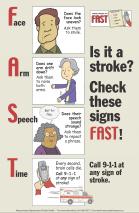The Cerebrovascular Disease and Stroke Program provides care for patients with various types of cerebrovascular and stroke-related conditions.
We treat a wide array of conditions, but the most common ones include aneurysms, AVMs (arteriovenous malformations), carotid artery stenosis, intracranial atherosclerosis, and strokes.
Where possible, refer to the linked pages on the Healthwise® Health Encyclopedia for more information about common conditions, tests, and treatments provided by the Cerebrovascular Disease and Stroke program:
- Aneurysm: Weakness or dilations of a blood vessel wall
- Arteriovenous Fistula (AVF): Abnormal connections of the arterial and venous systems
- Arteriovenous Malformations (AVM): Abnormal connections of arteries to veins, which can cause abnormal blood flow
- Carotid stenosis: Narrowing of one or both of the carotid arteries that irrigate a significant amount brain tissue
- Cerebral Cavernous Malformation (CCM): An abnormally formed cluster of enlarged blood vessels that can occur in the brain and spinal cord
- Developmental Venous Anomaly (DVA): The most common malformation of blood vessels, generally considered benign
- Moyamoya: A disorder of the arteries of the brain where there is progressive narrowing which can lead to stroke, seizures and loss of neurologic function
- Magnetic resonance angiogram (MRA): A type of MRI scan that uses a magnetic field and pulses of radio wave energy to provide pictures of blood vessels inside the body.
- Magnetic resonance imaging (MRI): A test that uses a magnetic field and pulses of radio wave energy to make pictures of organs and structures inside the body.
- Ischemic, hemorrhagic strokes and transient ischemic attacks (TIA): Blood clots or artery leaks causing strokes.
- Vein of Galen Malformation (VOG): Abnormal network of arteries and veins located deep within the brain. It places a varying amount of stress on the brain and other organ systems
Prevention
There are preventive measures you can take to reduce your chances of cerebrovascular diseases and strokes.
These include:
- Checking your blood pressure regularly to avoid hypertension (high blood pressure)
- Controlling existing high blood pressure by eating a low-sodium diet, maintaining a healthy weight, managing stress, and taking proper medications regularly
- Eating a healthy, low-fat diet
- Exercising regularly to keep your heart and blood vessels healthy
- Limiting alcohol intake to no more than one to two drinks a day
- Quitting smoking
- Seeing your doctor for regular medical check-ups
- Treating diabetes
For more information about prevention techniques, refer to the American Stroke Association.
Stroke warning signs
Cerebrovascular diseases can cause temporary stroke-like symptoms associated with transient ischemic attacks (TIAs). Because TIAs are an indicator of future strokes, learning to recognize the warning signs is important so you can call 911 for assistance, as quickly as possible.
We can provide treatment that greatly reduces the damage caused by TIAs and strokes; however, you need to arrive at the hospital soon after symptoms arise to avoid permanent impairment.
To learn how to recognize and respond to the signs of a stroke using the FAST model (Face, Arm, Speech, Time), watch the video below:
Watch the Stroke Heroes Act FAST video
The early signs of TIAs and strokes are sudden:
- Abnormal or slurred speech
- Comprehension difficulties
- Confusion, trouble speaking or understanding
- Drooling or difficulty eating or swallowing
- Numbness or weakness of the face, arm or leg, especially on one side of the body
- Severe headache with no known cause
- Trouble seeing in one or both eyes
- Trouble walking, dizziness, loss of balance or coordination
